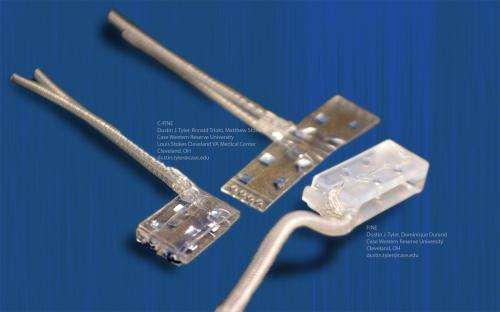December 6, 2013 weblog
A more natural sense of touch is brought to prosthetic hand (w/ Video)

(Phys.org) —The challenge in medicine to improve the lives of those in need of prosthetic limbs continues to motivate scientists, engineers and doctors. One newsworthy sign of progress is from a team of scientists and engineers at the Cleveland Veterans Affairs Medical Center and Case Western Reserve University. Their work is focused on a prosthetic hand capable of more natural feelings to the point where test subjects are able to find success in manipulating objects thanks to a better sense of touch.
Delivery of sensory information is involved in the research by a group led by Dustin Tyler, PhD, associate professor, Department of Biomedical Engineering, at the university. While electrical stimulation generally sends a "tingle" sensation, Tyler's team is able to deliver a heightened range of sensory sensation. Positioned on the prosthetic hand are numerous pressure sensors so that the amputee subject grabs an object and "feels" it and also can tell how tightly his hold is on the object. According to MIT Technology Review, the work is in a pilot feasibility trial stage, and Tyler said that, if all goes well, a device could be on the market in five to 10 years.
Back in October, their work was brought to the attention of oandp.com, an orthotics and prosthetics information site. The report said that Tyler's approach to electrical stimulation involved fine-tuning the information cutaneous sensory nerves perceive and transmit to the brain to create a natural sense of touch. Another noteworthy aspect of their work is enabling amputee subjects to enjoy that sense of hand control without intense visual concentration on movements. Towards that end, the team has done tests where the subject cannot see the objects yet can successfully pick them up and move them. The team's Box and Blocks Test occludes a subject's vision and white noise us used to block out motor auditory cues.
Meanwhile, a YouTube video that appeared in late October, "Restoration of Natural Sensation," showed a man using his prosthetic hand to pick up and remove stems from cherries under similar conditions where he could not see the objects. Blindfolds, headphones, and white noise were part of that test too. Without sensation, 9 out of 15 cherries were squished or damaged. With the sensation on, one out of 15 cherries was damaged. His strategy was to grab the cherry with two fingers which he could do with his prosthetic hand.
More information: www.youtube.com/watch?v=DIodb8qM9N0
© 2013 Phys.org


















